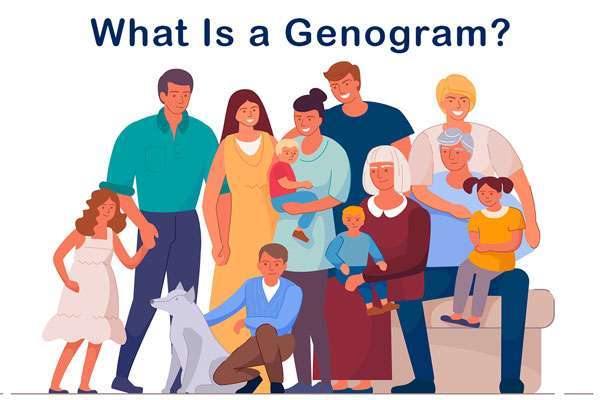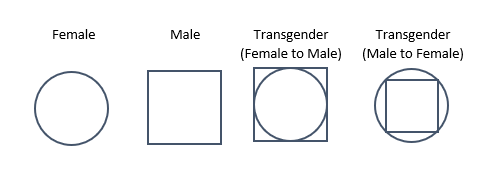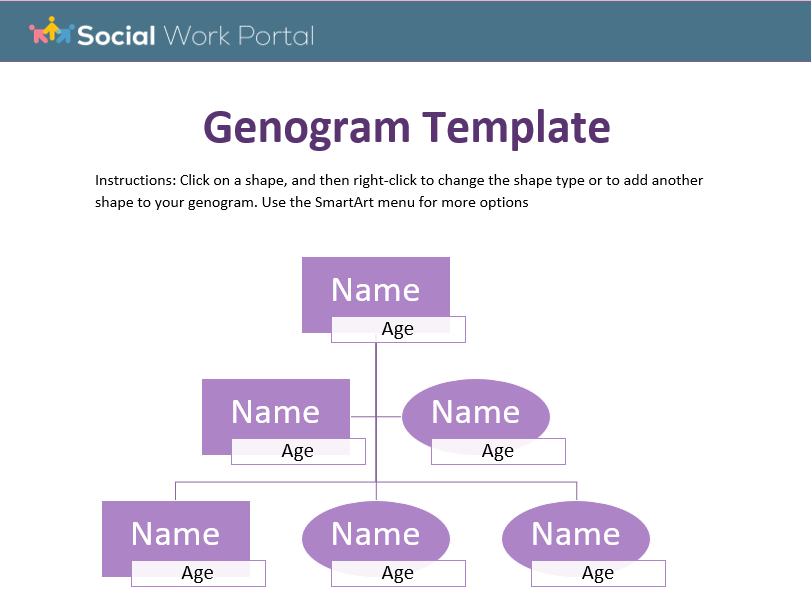Everything You Need to Know about Genograms in Social Work (With Free Downloadable Template)
Why are Genograms Really Important for Social Workers?
As a social worker, there are certain key factors you need to know about the family dynamics of a client that will be used in planning and providing the best social work care to that client.
To identify these key factors, social workers often have to chart the family connections for a client, and that involves the use of a Genogram.
Working with families is common in all types of social work and this is what makes social work genograms such a popular method of assessment.
In this article, we’ll review the genogram definition social work uses, why genograms are used, and the importance of genograms in social work and other fields of care.
See Also: Examples & Types of Social Service Programs

| Social Work Guide, Definition & Genogram Worksheet |
Table of Content
Keep on scrolling down this page to read each section, or click any link below to go directly to that section.
- What Is the True Definition of a Genogram?
- What Is a Genogram Really Used For?
- Types & Genogram Examples
- Genogram & Ecomap Tool
- Download Free Social Work Genogram Template PDF & Word
- Conclusion | How to Use a Genogram Social Work Template
Contact us if you have any questions or feedback about the genogram social work symbols outlined in this guide or any other geno grams questions.
There are cases where social workers may be working with a family as a whole, such as when assisting with the placement of an elderly relative (geriatric social work). In this case, a social worker may be supporting several family members as they go through the transition together, and the use of a Genogram will be needed to chart the family connections.
Medical social workers will also often offer comfort and guidance to families dealing with a family member’s medical crisis. Two other types of social workers that also work with families are school social workers and Foster Family/child protection social workers.

Don’t Miss: Principles of Social Work Used Within Social Work Methods
Questions about this genogram social work guide, examples of a genogram, or how to make a genomap? Contact us.

What Is the True Definition of a Genogram in Social Work?
A social work genogram is a visual representation of family relationships. If you glance at a genogram social work example, you might think that it’s the same thing as a family tree in genealogy, and you will be somewhat correct.
While a genogram does start out looking like a family tree, it’s more complex than that. It can include additional information on family connections, such as the status of an emotional relationship (Is it stressful? Positive? Or something else?). A genogram example social work professionals use can also include details such as significant medical information.
While all this could be included in a social worker’s assessment report for an individual or family, the point of genograms social work uses is to display a lot of information in an easy-to-read chart.
Social work genogram example charts make it easier for social workers and other care professionals to identify familial relationships and how they may impact therapeutic and support decisions.
 |
Searching for Social Work eLearning Videos? Join All-in-One Case Management Hub today and go to My Library! |
Genogram Definition
The description above is a less formal genogram definition social work professionals and students read to grasp the concept of what a genogram is. Here is the genogram definition from Wikipedia.
Wikipedia’s genogram definition social work students can refer to is, “A genogram (also known as a McGoldrick–Gerson study, a Lapidus schematic, or a family diagram) is a pictorial display of a person’s family relationships and medical history.
When answering, what is a genogram in social work, the explanation states further, “It goes beyond a traditional family tree by allowing the user to visualize hereditary patterns and psychological factors that punctuate relationships.”

Related: Psychosocial Assessment Template for Social Workers
Contact us if you have any questions or feedback about the genogram worksheet referenced in this guide, a genomap example, or anything else about geno grams.
What Is a Genogram in Social Work Really Used For?
Social work genograms are used for some of the following purposes:
- Assessment of relationship patterns impacting an individual
- Assessment of family dynamics
- Quick reference for medical risk factors
- To identify systems of support for an individual
- As a “cheat sheet” to understand how family members are connected
- To understand areas of family trauma
- As a tool for family therapy to understand and improve relationships
- … and more
A social worker who is working in a school environment, and trying to understand why a child is bullying other children will often use a social work genogram template designed to show emotional relationships between them and members of their family to look for signs of stress and tension that could be a contributing factor.
The genogram template social work professionals use is designed to be flexible enough to display several different types of information.
Are you frustrated with difficult case management apps without the assessments you need? Subscribe to our Simple, Effective Case Management Software.
Social workers will generally home in on a certain type of genogram, depending upon the work they are doing (clinical social work, medical social work, etc.)
A social worker that is using a strengths & solution-focused model, may create a genogram example social work chart to locate positive relationships in a family so they can reach out to those people asking for buy-in and support for a client’s care plan.
Popular Article: Risk Assessment Guide for Social Workers
Do you have any questions or feedback about genogram examples social work professionals use, making a genomap, or examples of a genogram? If so, click here to contact us.
Types & Genogram Examples Social Work Professionals Use
Now that you have a better understanding of genograms social work professionals use and the ways that a genogram worksheet can be used to enable social care professionals, we’ll take a look at several different types of genograms as well as several groups of genogram social work symbols.
The basic components of genograms social work professionals use are shapes to represent the people in the family and lines to represent the connections between those people.
Both the type of shape and type of line you use have meaning, which we’ll get into next.
Family Genogram Social Work Symbols
The symbols that make up a genogram social work example chart provide a lot of information in a small amount of space. For example, one symbol might denote suspected drug or alcohol abuse, another might indicate a stressful relationship between siblings.
Because of the intricate nature of genogram social work symbols, there will usually only be one type of genogram used at a time. We’ll get into social work genograms and their types in a moment, but first, we’ll discuss the basic symbols used in many genograms.
|
Better Case Assessment & Management Software Join the Case Management Hub Platform today! |
|
Gender
The most basic symbols that are displayed in all types of genogram examples social work uses are for gender.
A circle is used to represent a female, a square is used to represent a male. A circle inside a square can be used to represent transgender (female to male), and a square inside a circle can be used to represent transgender (male to female.

Basic gender representations social work genogram example.
A person’s name and age can be placed either inside or above the symbol that represents them on the genogram worksheet.
There are several other social work genogram examples and medical symbols that are used in different types of genograms, which we’ll cover below.
Different Types of Genogram Social Work & Medical Professionals Use
When looking for a genogram social work template, it helps if you already know the type of genogram you’d like to create. There are different types of genograms in social work that can be used, depending on the needs of the social worker.
One important thing to note is that you can adjust your social work genogram template to display information in the way you find most helpful. For example, you can add colors to relationship lines to help you immediately tell a positive relationship (green) from a stressful one (red).
You can also use as many or few lines and symbol types as you find helpful. One genogram social work example might use 10 different emotional relationship lines, while another might use just 3.
The point is that the genogram template social workers use is customizable. Once you learn the basics, you can adjust the shapes and lines you use as you like.
Read More: Tools and Methods of Evaluation in Social Work
Please let us know if you have any questions about making a genomap example, or example of a genogram and ecomap combo.
Emotional Relationships Genogram
An emotional relationships social work genogram example uses lines to represent the relationships between family members. It will use a solid line to represent a strong relationship and a jagged line to indicate one that is stressful.
This social work genogram helps social workers understand where stress or support may be within a family group. It can be used as a way to illustrate negative influences on a client and as a way to seek out areas of support.
Want to boost your client assessments to a new level? Try our All-in-One Client Assessment & Management Hub today – for free!
When using a social work genogram template Word downloadable, you may find a full range of different line examples, like these.

Social Work Genograms – Emotional Relationships Example

Family Relationships Genogram
The next type of social work genograms that are used in social work use lines to denote types of family relationships rather than the emotions of the relationship.
This genogram will use lines to represent married divorced, cohabitation, separation, etc. Here are some standard examples from Wikipedia.

Source: Wikipedia
Medical Genogram
The third type of genogram social work example that you’ll see used in both the social work and medical field is a medical genogram.
This one will use an additional shape next to the shape denoting gender. The medical shape will have a color inside to indicate various hereditary medical conditions, such as heart disease or breast cancer. Other non-hereditary medical factors can also be noted, such as smoking or substance abuse.
This is used to help chart risk for a patient based on a family’s medical history and other influences (e.g., drug use) that a client may have in their home.
 Medical symbols in genograms social work professional use.
Medical symbols in genograms social work professional use.
Different Formats for a Genogram Template Social Work Chart
Once you decide on the genogram example social work type you plan to use, there are a few different ways that you can create your genogram. These include:
- Social work genogram template Word document
- Genogram social work template in Excel
- Create a social work genogram template in a diagramming program (like Visio)
Related: Social Work Theories Cheat Sheet for All Social Workers
Contact us if you have any questions or feedback about this end-to-end social work genogram guide, finding an example of a genogram, or geno grams cloud tools. Also, if you would like a quick demo of any of our social work templates or guides, feel free to reach out.
Free Social Work Genogram Template PDF & Word
This template uses SmartArt in Microsoft Word, making it easy for you to create a basic genogram for your needs. On page 2 of this downloadable genogram example social work template, you’ll find a reference for the emotional relationship lines. We hope you find this genogram template helpful!
Sign up and download your copy of the Social Work Portal Genogram Template PDF & Word

Don’t Miss: What Are the Real Responsibilities of a Social Worker?
Contact us if you have any questions or feedback about this end-to-end social work genogram guide, a genomap template, or finding another example of a genogram.
Conclusion | How to Use a Genogram Social Work Template
Social work genograms are a helpful tool for visualizing different types of family information comprehensively. Genograms in social work can be used to review risk factors for hereditary diseases, as well as review the health of different family relationships.
Social work genogram templates can be combined with an ecomap (another type of social work report). The social work ecomap expands the relationship view past the family to friends and community connections.
Once you know the basics of how to fill out a genogram worksheet and generate a genogram, you can begin to personalize your genogram reporting to include factors and representations that are most meaningful to your needs.

Popular Article: What Are the Different Types of Social Workers
Importance of Genograms in Social Work FAQ
What is a genogram in social work?
A social work genogram is a visual representation of family relationships. If you glance at a genogram social work example, you might think that it’s the same thing as a family tree in genealogy.
While a genogram does start out looking like a family tree, it’s more complex than that. It can include additional information on family connections, such as the status of an emotional relationship or medical information.
What do genograms look like?
The basic components of genograms social work professionals use are shapes to represent the people in the family and lines to represent the connections between those people.
Both the type of shape and type of line you use have meaning.
What are the different types of genograms in social work?
When looking for a genogram social work template, it helps if you already know the type of genogram you’d like to create. There are different types of genograms in social work that can be used, depending on the needs of the social worker.
Types of genograms are:
• Emotional Relationship Genogram
• Family Relationship Genogram
• Medical Genogram
What are common genogram social work symbols?
The most basic symbols that are displayed in all types of genogram examples social work uses are for gender.
A circle is used to represent a female, a square is used to represent a male. A circle inside a square can be used to represent transgender (female to male), and a square inside a circle can be used to represent transgender (male to female).
Note: Content on this website (socialworkportal.com) is copyrighted and protected under applicable copyright laws. Unauthorized reproduction, distribution, or use of any content from the website, without explicit written permission, is strictly prohibited. Read: Terms of Use.
Social Work Portal Disclaimer: Social Work Portal is not a social work agency and we do not refer social workers. This web site is provided for educational and informational purposes only and does not constitute providing medical advice or professional social and healthcare services. The information provided should not be used for diagnosing or treating a health problem or disease, and those seeking personal medical advice should consult with ... Read our full disclaimer here: Social Work Portal Disclaimer.

Image sources:
- Stock.adobe.com
- https://en.wikipedia.org/wiki/Genogram#Purpose





